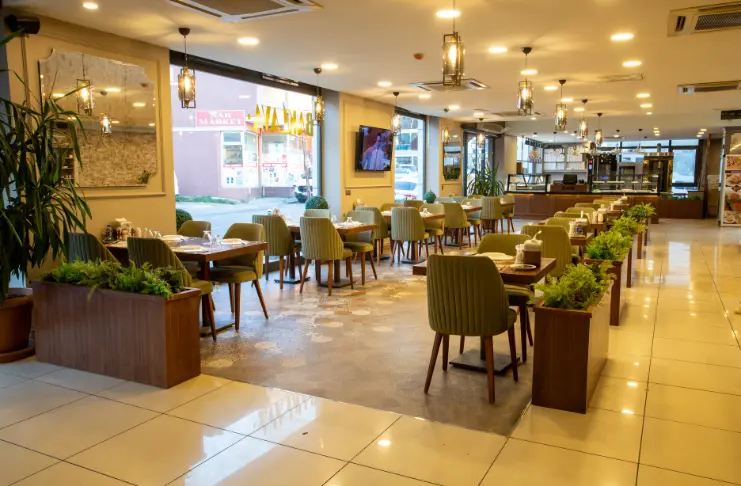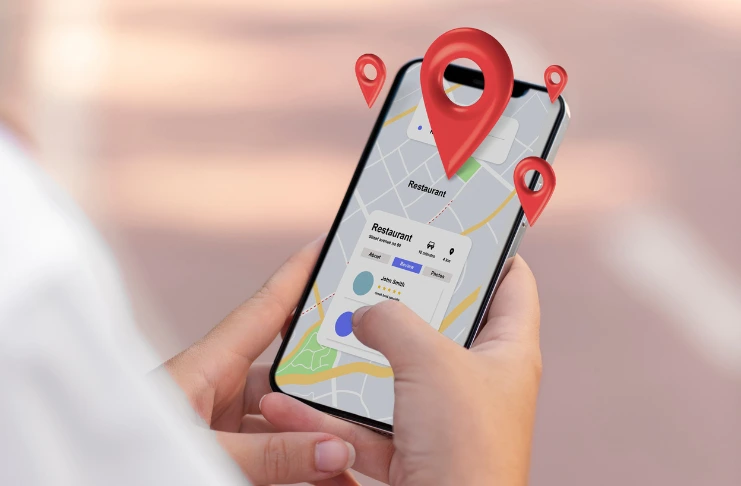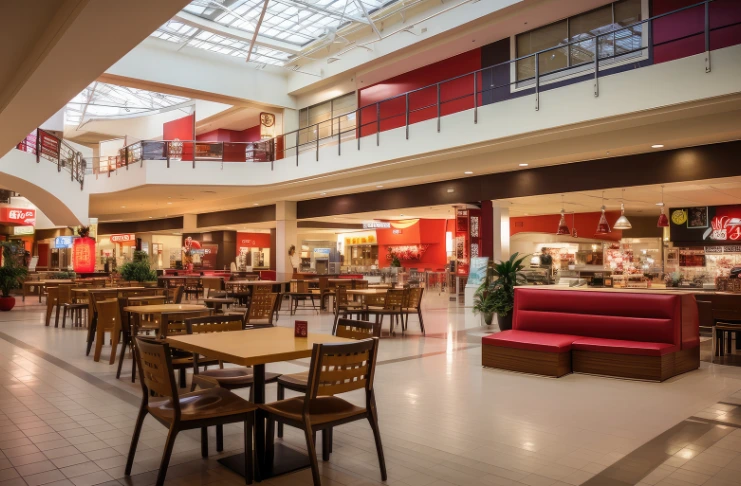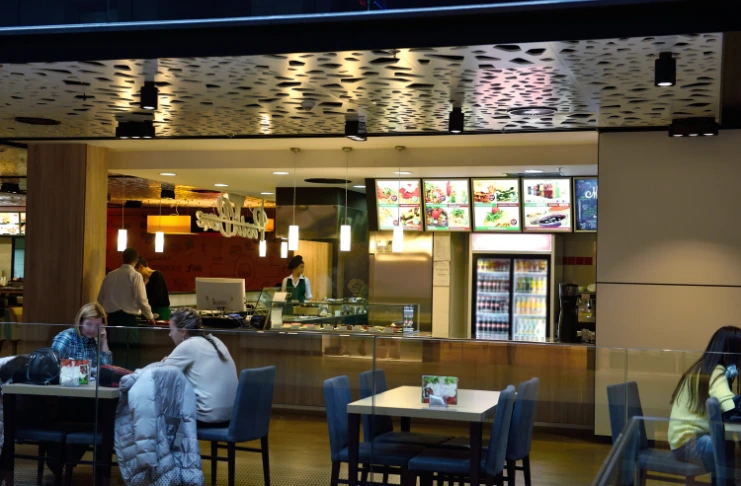Are you considering opening a restaurant in a food court? This business decision represents a unique path in the food service industry that comes with its own set of advantages and challenges.
Food courts have evolved significantly over the years. No longer limited to shopping malls, they now appear in office complexes, airports, and entertainment venues, making them potentially lucrative locations for small businesses and restaurant entrepreneurs. With lower initial investments, built-in foot traffic, and shared operational responsibilities, food court restaurants offer an attractive option if you’re looking to enter the restaurant business.
However, operating in a shared environment comes with trade-offs. You’ll have less control over your branding, ambiance, and the overall customer experience. Your success will also be somewhat tied to the performance of the location where your food court is situated.
The key is understanding what you’re getting into before making the commitment. While you might have less creative control than in a standalone restaurant, the reduction in overhead costs and operational complexities can make the model very appealing.
In this comprehensive guide, we’ll explore everything you need to know about opening a restaurant in a food court. From weighing the pros and cons to understanding financial considerations and operational requirements, you’ll gain insights to help determine whether this business model aligns with your goals and vision.
What’s your biggest concern about opening a restaurant in a food court? Is it the startup costs, the limited space, or perhaps the dependency on location traffic? Your specific questions and concerns will help shape our discussion throughout this guide!
What Exactly Is a Food Court Restaurant?

Food courts typically feature multiple food service establishments sharing common seating areas, creating a diverse culinary marketplace under one roof. Unlike standalone restaurants, food court venues focus primarily on counter service with simplified operations and streamlined menus, making them ideal for serving customers quickly during shopping breaks or lunch hours. When considering opening a restaurant in a food court, entrepreneurs benefit from this efficiency-focused model that prioritizes quick turnover and accessibility.
The pros and cons of food court restaurants often center around this shared environment, where mall-based restaurant business strategy emphasizes speed and convenience over extensive dining experiences. This distinction between food court vs standalone restaurant operations is crucial for those weighing the benefits of food court restaurant outlets against the challenges of running a food court restaurant, particularly when evaluating food court rental costs and operating costs for restaurants against potential foot traffic advantages.
INDUSTRY INSIGHT
| According to IBISWorld, the U.S. food court and food hall industry is projected to reach 8.7% to $574.0 million over the next five years, signaling a strong post-pandemic recovery and renewed investor confidence in this format. |
The Modern Food Court Evolution
Today’s food courts have evolved significantly from their origins in the 1980s and 1990s. The National Restaurant Association reports that modern food courts are increasingly featuring:
- Chef-driven concepts rather than just fast-food chains
- Local and independent restaurant operators
- Elevated dining experiences with better seating and ambiance
- Diverse international cuisine options
- Integration with entertainment and shopping experiences
This evolution creates opportunities for entrepreneurs looking to establish distinctive culinary brands in shared dining spaces.
The Pros and Cons of Food Court Restaurants

Before diving into this business model, you should carefully weigh the pros and cons of food court restaurants. Let’s examine both sides:
Key Benefits of Food Court Restaurant Outlets
1. Built-in Customer Traffic
Opening a restaurant in a food court offers built-in foot traffic, reducing the need for extensive marketing and providing constant visibility among shoppers.
2. Lower Initial Investment
Food court restaurants generally require a lower initial investment compared to standalone restaurants, thanks to smaller spaces, shared utilities, fewer employees and simpler design needs.
3. Simplified Operations
Food court operations are streamlined with smaller menus, counter service, and fewer staff, allowing you to focus on food quality and customer satisfaction.
4. Flexible Hours and Shared Security
Mall hours provide structure, eliminating the need to set independent operating times while offering predictable hours for businesses. Shared services like security, maintenance, and cleaning reduce operational burdens and keep costs lower for food court restaurants.
5. Marketing Support from the Mall
Many malls offer marketing support for food court restaurants, including inclusion in advertising campaigns, promotions, and social media cross-promotion to drive traffic.
Overall, opening a restaurant in a food court can be a strategic move for entrepreneurs looking for high visibility, lower startup costs, and operational simplicity—making it a compelling alternative to traditional standalone restaurant models.
Challenges of Running a Food Court Restaurant
1. Limited Menu Flexibility
Food court restaurants operate with streamlined menus for quick preparation. This efficiency can limit culinary creativity and seasonal offerings, focusing mainly on portable, easy-to-eat foods with minimal customization and faster prep times compared to standalone restaurants.
2. Competitive Environment
Your food court restaurant will compete with multiple vendors for the same customers. To succeed, you’ll need a strong differentiation strategy, competitive pricing, effective visual merchandising, and the ability to create excellent first impressions.
3. Mall-Dependent Performance
Opening a restaurant in a food court means your success is tied to the mall’s overall performance. Seasonal fluctuations, mall renovations, anchor store closures, changes in mall management, and economic downturns can all impact your sales.
4. Limited Operating Hours
Unlike standalone restaurants, food court restaurants must adhere to the mall’s operating hours, which limits your ability to capture early morning or late-night diners, potentially affecting revenue from those time slots.
5. Shared Ambiance and Limited Control
Food court dining lacks the atmospheric control found in standalone restaurants. Factors like lighting, background music, seating arrangements, and cleanliness are determined by the mall, limiting your control over the dining experience, even though ambiance is important to diners.
While opening a restaurant in a food court offers several operational advantages, it’s important to weigh the limitations, like reduced control, stiff competition, and dependency on mall dynamics, before deciding if this model aligns with your long-term restaurant business strategy.
Food Court vs. Standalone Restaurant: Key Differences

When deciding whether opening a restaurant in a food court makes sense for your business, consider these fundamental differences:
1. Rental Structure and Costs
- Opening a restaurant in a food court involves unique leasing structures that differ from standalone restaurant models.
- Rental rates in high-traffic malls range from $50 to $150 per square foot annually, depending on location and demand.
- Leases often include base rent plus a percentage of gross sales.
- Additional costs include common area maintenance (CAM) fees and marketing contributions.
- Lease terms are typically 3–5 years, offering flexibility but at higher per-square-foot costs.
These factors make it essential to carefully assess your budget and long-term goals before committing to a food court lease, ensuring the model aligns with your overall restaurant business strategy.
2. Customer Dwell Time
- Shorter dining times are a key characteristic of food court restaurant outlets.
- Food court diners spend 22–28 minutes on average per visit, compared to 45–65 minutes at standalone restaurants
- Alcohol service is often restricted or unavailable in food courts.
- The fast-paced environment promotes a “grab-and-go” mindset.
- Shared seating areas discourage lingering, leading to higher turnover.
This shorter dwell time requires operational efficiency but also means higher customer turnover potential.
3. Brand Identity Challenges
- Creating a distinct brand presence in a food court comes with several limitations.
- Limited storefront visibility, usually restricted to counter space and signage.
- Minimal control over ambiance, as mall design dictates the environment.
- Reduced opportunities for custom interior design or layout.
- Shared aesthetics make it harder to stand out from nearby vendors.
- Many operators report brand visibility as a top concern
These limitations highlight the importance of strategic branding, compelling visuals, and a consistent customer experience to effectively differentiate your restaurant in a competitive food court environment.
Financial Considerations for Food Court Restaurants

Understanding the financial aspects of food court restaurant outlets is essential for making an informed decision:
1. Startup Costs
- Lower Initial Investment: Food court restaurant startups typically range from $200,000 to $500,000, much lower than standalone locations, which can exceed $1 million.
- Lease Costs: Monthly rent for food court spaces averages between $3,000 and $10,000, depending on the location.
- Equipment & Furnishings: Kitchen equipment and furnishings typically cost $50,000 to $100,000, based on your restaurant size.
- Marketing & Branding: Initial marketing costs, including digital ads, range from $5,000 to $10,000 for food court restaurants.
- Renovations & Leasehold Improvements: Customization and renovations may cost between $75,000 and $200,000, depending on the space.
Understanding these startup costs is crucial for anyone considering a food court restaurant, helping you plan effectively and ensure a smooth launch in this unique business environment.
2. Profitability Metrics
Food court restaurants typically operate with different profitability metrics compared to standalone restaurants. These metrics reflect the streamlined operations and cost-effective nature of food court outlets:
- Average Check Size: $8–$12, lower than standalone casual dining establishments ($15–$25).
- Daily Transactions: It is generally observed that these establishments experience higher foot traffic compared to standalone restaurants, leading to increased daily transactions, which is exactly the case for food courts present in malls and other high footfall places.
- Food Cost Percentage: 28–35%, slightly lower than standalone models due to a more limited menu and faster prep times.
- Labor Cost Percentage: 20–25%, which is lower than the 30–35% typically seen in full-service, standalone restaurants.
- Net Profit Margin: It is observed that food court eateries outperform standalone restaurants that typically have lesser net profit margins.
These profitability metrics highlight the benefits of opening a restaurant in a food court, offering higher customer turnover, lower overhead costs, and improved margins, making it an attractive option for restaurateurs looking to optimize profitability.
3. Break-Even Timeline
- Faster Break-Even: Food court restaurants generally reach profitability quicker than standalone locations, often in 6-10 months, due to lower startup costs and high customer turnover.
- Quicker Profitability: This faster timeline offers a significant advantage for new restaurant owners looking to minimize risk.
- Attractive for Entrepreneurs: Opening a restaurant in a food court provides a quicker return on investment compared to standalone restaurants.
These insights highlight how opening a restaurant in a food court offers a faster path to profitability compared to standalone restaurants.
Is a Food Court Location Right for Your Restaurant Concept?

Should you open a restaurant in a food court? This question requires careful assessment of your concept’s compatibility with the food court environment:
Concepts That Thrive in Food Courts
Some restaurant concepts perform exceptionally well in food court settings:
- Fast-Casual Ethnic Cuisine: Global flavors like Asian, Mediterranean, and Mexican are increasingly popular and often surpass traditional offerings in terms of consumer demand.
- Desserts & Snacks: Items like bubble tea, pretzels, and ice cream drive impulse sales, especially in high-traffic areas.
- Healthy Fast Food: 88% of consumers are willing to pay more for healthier food options—a great fit for health-focused food court concepts.
- Customizable Meals: “Build-your-own” options like salads, bowls, and sandwiches see higher satisfaction ratings in food courts.
These high-performing concepts highlight how food court restaurants can capitalize on speed, flavor variety, and consumer trends—making them ideal for entrepreneurs seeking a scalable, customer-driven business model.
Concepts Less Suited for Food Courts
Some restaurant concepts face challenges in food court environments:
- Fine Dining or Full-Service Concepts: The rushed atmosphere and shared dining space make upscale dining experiences difficult to execute properly.
- Concepts Requiring Tableside Service: Without dedicated servers and table assignments, concepts requiring attentive service struggle in food courts.
- Cuisine Requiring Extensive Preparation Time: Food court customers typically expect service in under 5 minutes, making concepts with lengthy preparation times impractical.
- Alcohol-Focused Concepts: Many food courts restrict alcohol service or limit it to designated areas, creating challenges for concepts relying on beverage sales.
When evaluating your restaurant concept, consider whether it aligns with the fast-paced, streamlined nature of food court dining to ensure long-term success in this unique environment.
Developing a Mall-Based Restaurant Business Strategy

Creating a successful mall-based restaurant business strategy requires specialized approaches:
1. Menu Engineering for Food Courts
Effective food court menus share certain characteristics:
- Concise Offerings by limiting menus to 8–15 items can streamline operations and reduce customer decision fatigue.
- Quick Preparation, as dishes are designed for preparation times under 5 minutes, aligns with customers’ expectations for fast service at the food court.
- High-quality images and visually appealing displays can entice customers and highlight signature items.
- Menu items optimized for easy consumption on the go cater to the food court environment’s transient nature.
- Strategic pricing, such as using round numbers and omitting currency symbols, can make items more appealing and competitive.
By crafting a food court menu that emphasizes speed, simplicity, visual appeal, and portability, restaurant owners can maximize customer satisfaction and operational efficiency—key drivers of success in high-traffic mall environments.
2. Visual Merchandising Strategies
With limited space, impactful visual merchandising is crucial:
- Utilize eye-catching menu boards with high-resolution food photography to attract attention.
- Display sample dishes or models to showcase offerings.
- Incorporate action stations where customers can observe food preparation, enhancing engagement.
- Implement strategic lighting to highlight your counter space and products.
- Design distinctive staff uniforms to reinforce brand identity.
Effective visual merchandising can significantly boost sales by capturing customer interest and enhancing the shopping experience.
3. Operational Efficiency
High-performing food court restaurants prioritize operational efficiency:
- Design kitchen layouts optimized for high-volume production.
- Cross-train staff to handle multiple stations, ensuring flexibility.
- Implement streamlined POS systems with intuitive interfaces to expedite transactions.
- Adopt batch cooking and assembly-line preparation methods to maintain speed and consistency.
- Optimize inventory management for limited storage spaces, reducing waste and ensuring availability.
These strategies are essential for running a profitable food court restaurant, where speed, consistency, and efficiency directly impact customer satisfaction and overall success.
4. Marketing Beyond the Mall
While mall traffic provides a steady customer base, expanding your marketing efforts can drive additional growth:
- Develop a robust social media presence to showcase new menu items and promotions.
- Implement loyalty programs to encourage repeat visits and build customer relationships.
- Offer catering services to nearby businesses, tapping into new revenue streams.
- Partner with delivery platforms to reach customers beyond the mall premises.
- Consider developing packaged retail products to diversify income sources.
Investing in comprehensive marketing strategies can lead to significant revenue growth.
By focusing on streamlined menus, compelling visual merchandising, efficient operations, and expansive marketing, mall-based restaurants can thrive in the competitive food court landscape.
Success Stories: Food Court Restaurants That Expanded

Several well-known restaurant chains started in food courts and scaled rapidly:
- Panda Express launched in a mall food court in 1983 and now operates over 2,200 locations across the U.S.
- Auntie Anne’s began as a market stand in 1988 and expanded globally through food court strategies, with over 1,800 locations.
- Sarku Japan started in a mall food court and now runs over 200 locations in the U.S. (Sarku Japan).
- Charleys Philly Steaks grew from one location near Ohio State University to 600+ locations, many within the mall food courts (Charleys).
These restaurant success stories highlight how food court restaurant concepts can serve as cost-effective, high-traffic launch platforms for national expansion.
Common Mistakes to Avoid When Opening a Food Court Restaurant

Avoid these pitfalls when opening a restaurant in a food court:
- Underestimating Equipment Needs: Even with limited space, selecting the right equipment is vital. Inadequate equipment planning can lead to operational inefficiencies.
- Neglecting Staff Training: Effective training enhances efficiency and customer service. Well-trained staff contribute to better customer experiences, which are essential in the fast-paced food court environment.
- Failing to Differentiate: With competitors nearby, offering unique menu items or experiences can attract customers. Differentiation helps in standing out in a crowded food court.
- Ignoring Mall Demographics: Tailoring offerings to the specific demographics of a mall’s clientele can boost sales. Understanding the local customer base is key to menu and marketing strategies.
- Overlooking Technology Integration: Implementing technologies like self-ordering kiosks and mobile ordering can enhance efficiency and customer satisfaction. Embracing tech solutions is increasingly important in modern food service.
By proactively addressing these areas, food court restaurateurs can position themselves for greater operational efficiency and customer satisfaction.
The Evolving Food Court Landscape

The food court model continues to evolve beyond its traditional roots, offering new opportunities and challenges for aspiring restaurant owners. Today’s food court concepts are responding to changing consumer preferences and technological advancements in ways that create exciting possibilities for entrepreneurs.
- Food Halls vs. Traditional Food Courts
Upscale food halls featuring local chefs and artisanal vendors are increasingly replacing traditional food courts across the country. These modern interpretations offer more curated, unique dining experiences that focus on quality and authenticity rather than just convenience. Food halls often showcase local culinary talent, creating community gathering spaces where diners can experience multiple culinary styles in one visit.
The shift from generic national chains to local, chef-driven concepts represents a significant opportunity for independent restaurateurs to access prime retail locations without the overwhelming costs of standalone establishments. These venues typically feature higher-quality design elements, communal seating arrangements, and a focus on creating an atmosphere that encourages longer visits and greater customer engagement.
- Integration with Entertainment
Modern food courts are no longer just places to grab a quick bite—they’re becoming destinations in themselves by incorporating entertainment features. From live music performances and cooking demonstrations to art installations and interactive displays, these additions are designed to increase dwell time and create more memorable dining experiences.
This entertainment integration creates additional value for both customers and vendors. For restaurant owners, the extended customer stays often translate to higher average sales and increased opportunity for repeat business. The communal atmosphere and regular events can help build loyal customer bases more quickly than traditional food court operations.
- Technology Integration
The digital revolution has reached food courts, with self-ordering kiosks, mobile ordering platforms, and integrated payment systems becoming standard features rather than luxuries. These technological advancements are streamlining operations, reducing labor costs, and meeting customer expectations for convenience and speed.
Restaurant owners can leverage these technologies to gather valuable customer data, implement loyalty programs, and manage inventory more efficiently. The reduced need for front-of-house staff allows operators to focus resources on food quality and kitchen operations. Additionally, integration with third-party delivery services has opened new revenue streams for food court businesses, extending their reach beyond the physical location.
- Sustainability Focus
Environmental consciousness has become a critical factor in food court success. Eco-friendly packaging, waste reduction initiatives, and sustainable sourcing are increasingly important to today’s consumers. Food courts and their vendors are responding with compostable containers, energy-efficient operations, and transparent sourcing practices.
These sustainability efforts often resonate strongly with customers, particularly younger demographics who prioritize environmentally responsible dining options. Smart operators are finding that sustainability initiatives not only attract conscious consumers but can also reduce costs through efficient resource management and waste reduction.
As food courts continue to transform, they present evolving opportunities for restaurant entrepreneurs. The successful food court restaurant of tomorrow will likely embrace these trends while maintaining focus on culinary quality and operational efficiency. By understanding these industry shifts, you can position your food court concept to thrive in this changing landscape.
Whether you’re drawn to the community aspect of food halls, excited about integrating entertainment elements, ready to embrace new technologies, or committed to sustainable practices, today’s evolving food court model offers multiple pathways to success for the savvy entrepreneur, as you consider this business model, think about how these trends align with your vision and how you might incorporate them into your own food court success story.
Is a Food Court Restaurant Right for You?

Should you open a restaurant in a food court? Before making this important business decision, consider these critical assessment questions:
- Is your concept designed for the limited kitchen space typical of food court restaurant outlets?
- Can your menu items meet the quick preparation demands of a mall-based restaurant business strategy?
- Does your concept visually stand out among competing food court restaurants, offering clear differentiation?
- Do your startup funds align better with the lower food court rental cost for restaurants versus standalone locations?
- Does your concept appeal to the specific demographics visiting this mall, addressing the pros and cons of food court restaurants?
If you answered “yes” to most of these questions, opening a restaurant in a food court might be an excellent fit for your entrepreneurial journey, balancing the challenges of running a food court restaurant with the potential benefits.
Conclusion
As we’ve explored throughout this guide, opening a restaurant in a food court offers distinct advantages for entrepreneurs looking to establish a food service business with lower initial investments and built-in customer traffic. Food court restaurants generally require less capital, offer quicker break-even timelines, and benefit from high foot traffic, making them an attractive choice for new restaurateurs.
However, there are challenges to consider, such as limited customization options, shared dining environments, and dependency on the performance of the host location. Despite these limitations, many successful restaurant brands have used food courts as stepping stones for significant growth.
The constraints of a food court environment can actually help you focus on what truly matters—exceptional food and efficient operations. With success in this model, you might find yourself with enough capital and experience to expand to additional locations or even venture into standalone concepts with the valuable lessons you’ve learned.
By understanding the operational requirements, financial considerations, and strategic approaches needed for success in food courts, you can determine if this business model aligns with your entrepreneurial goals. If you’re considering opening a restaurant in a food court, carefully weighing these pros and cons is essential.
This path isn’t for everyone, but food court restaurants can provide not just a viable business model but also a strategic launching pad for broader culinary ambitions. Whether it’s the lower initial investment or the operational simplicity that attracts you, understanding these factors will help you make an informed decision about whether a food court restaurant is the right move for your entrepreneurial journey.
What will your food court success story look like? The possibilities await those ready to embrace both the advantages and challenges of this unique restaurant model.
Frequently Asked Questions
1. Do food courts make money?
Yes, food court restaurants can be highly profitable due to high foot traffic, lower labor costs, and reduced overhead.
2. Is $10,000 enough to open a restaurant?
$10,000 may cover a small kiosk or cart, but it’s generally insufficient for a full restaurant setup—even in a food court.
3. How much does it cost to open my own restaurant?
Opening a restaurant can cost anywhere from $95,000 to $500,000, depending on size, location, and concept.
4. What is the minimum amount to open a restaurant?
At a minimum, expect to invest around $50,000 for a very small or low-frills food court setup.
5. What are the advantages of food courts?
Food courts offer shared overhead, built-in foot traffic, and lower startup and labor costs.
6. What is the difference between a food court and a restaurant?
A food court is a shared dining area with multiple vendors, while a restaurant is a standalone dining establishment.
7. Should I tip at the food court?
Tipping is not expected at food courts, but it’s appreciated if there’s a tip jar or service is exceptional.
8. Are food courts profitable?
Yes, food court outlets can achieve net profit margins of 8–15%, often higher than standalone restaurants.
9. What is the difference between a food court and a dining hall?
Food courts serve multiple commercial brands; dining halls are typically institutional for instance schools, with prepaid meal plans.
10. Why are there food courts in malls?
Food courts provide convenient dining options, increase shopper dwell time, and drive overall mall revenue.
11. What is the difference between a restaurant and a fast food outlet?
Fast food outlets focus on speed, low cost, and limited menus; restaurants may offer full service, ambiance, and broader menus.





